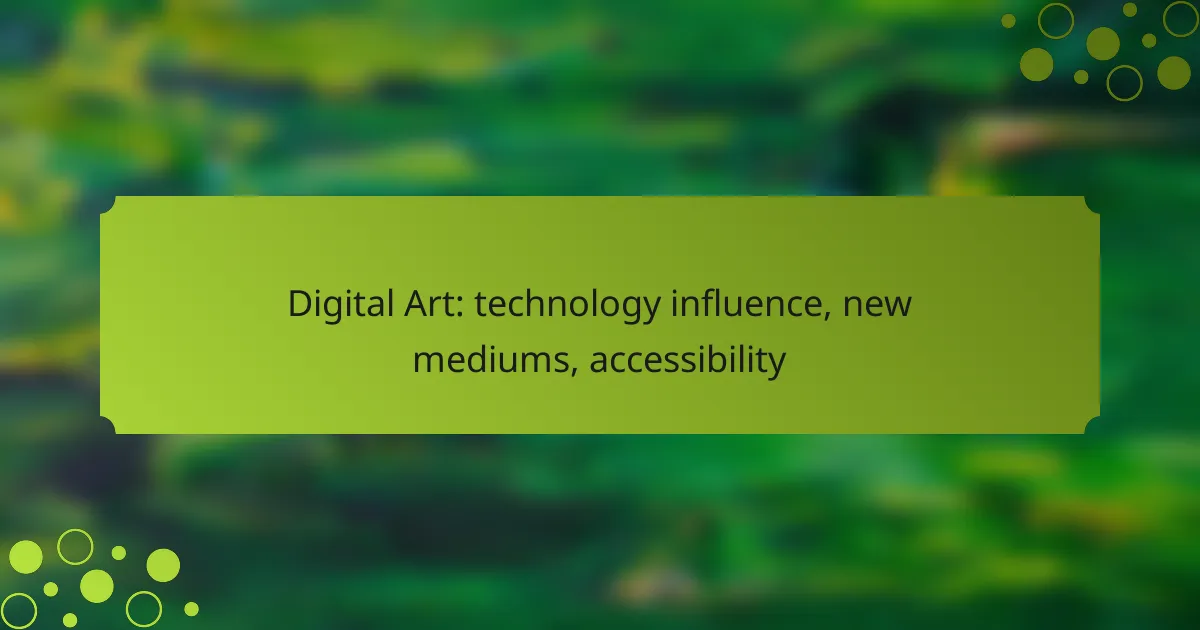Digital art is experiencing a transformative shift as technology introduces innovative tools and platforms that enhance creativity and accessibility. With the rise of new mediums such as augmented reality and interactive web platforms, artists can now create immersive experiences that redefine traditional art forms. This evolution is further supported by affordable software and community initiatives, enabling a diverse range of individuals to express their creativity and share their work with a global audience.
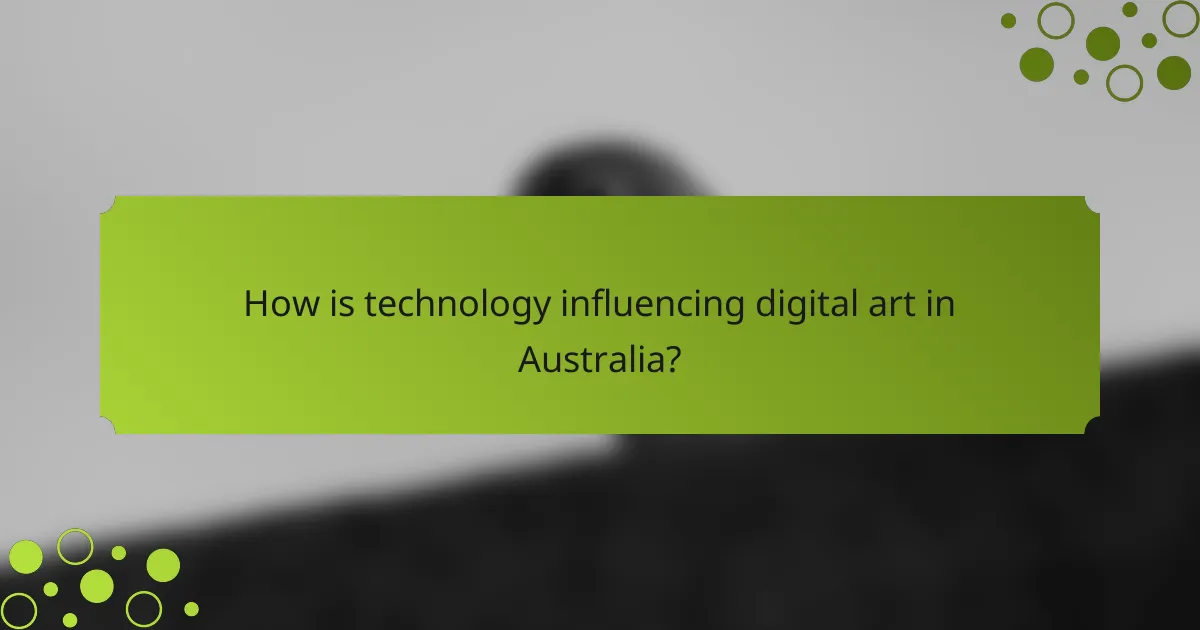
How is technology influencing digital art in Australia?
Technology is reshaping digital art in Australia by introducing innovative tools and platforms that enhance creativity and accessibility. Artists are now able to explore new mediums and reach wider audiences, thanks to advancements in software, hardware, and online distribution channels.
AI-generated artworks
AI-generated artworks are becoming increasingly popular among Australian artists, allowing for the creation of unique pieces through algorithms and machine learning. These tools can analyze vast datasets to produce art that reflects various styles and influences, often resulting in surprising and innovative outcomes.
Artists can use platforms like DALL-E or Midjourney to generate images based on textual prompts, which can serve as inspiration or even final works. However, it’s essential to consider the ethical implications of AI art, including issues of originality and copyright.
Virtual reality experiences
Virtual reality (VR) is transforming how audiences engage with digital art in Australia, offering immersive experiences that traditional mediums cannot replicate. Artists can create 3D environments where viewers can interact with the artwork, providing a deeper emotional connection.
Platforms like Oculus and HTC Vive enable artists to showcase their work in virtual galleries, allowing for global reach. However, artists should be mindful of the technical requirements and costs associated with VR development, as well as the learning curve for both creators and users.
Blockchain for ownership
Blockchain technology is revolutionizing ownership and provenance in the digital art world, particularly in Australia, where artists are exploring non-fungible tokens (NFTs). NFTs allow creators to tokenize their artwork, providing a secure way to verify authenticity and ownership on the blockchain.
By selling NFTs, artists can retain a percentage of future sales, creating ongoing revenue streams. However, artists should be aware of the environmental impact of blockchain transactions and consider platforms that use eco-friendly practices, such as those based on proof-of-stake systems.
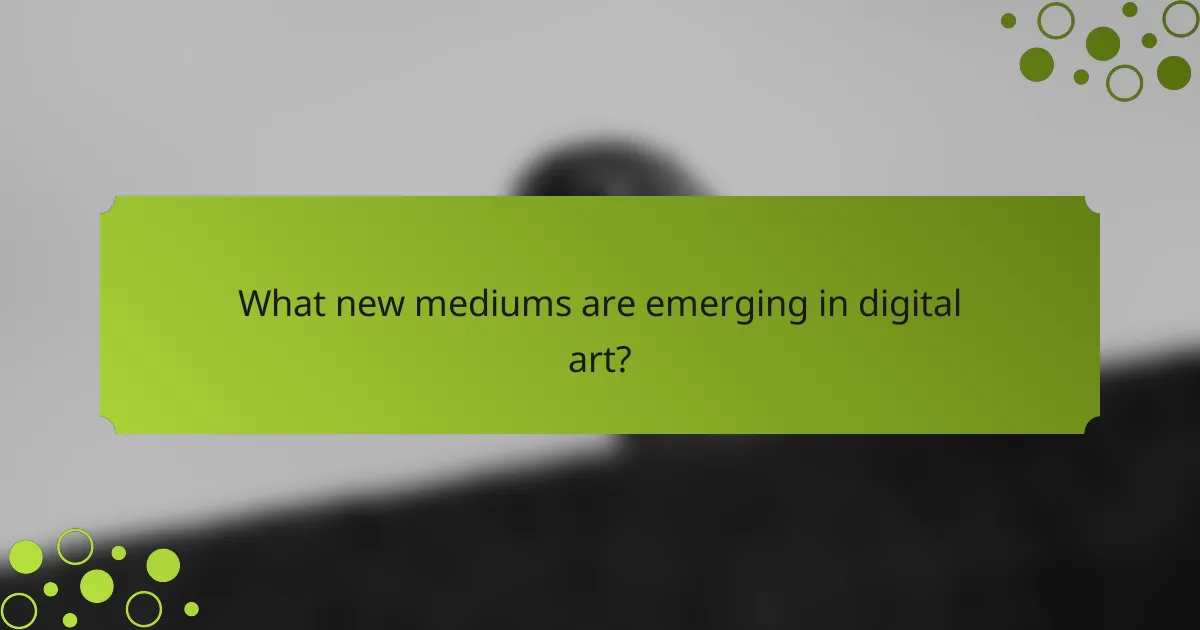
What new mediums are emerging in digital art?
Emerging mediums in digital art include innovative technologies that enhance creativity and interactivity. Artists are increasingly utilizing augmented reality, interactive web platforms, and 3D printing to create immersive experiences and redefine traditional art forms.
Augmented reality installations
Augmented reality (AR) installations blend digital content with the physical environment, allowing viewers to engage with art in new ways. Artists can create immersive experiences where users interact with virtual elements through smartphones or AR glasses. This medium encourages participation and can transform public spaces into dynamic art galleries.
When creating AR installations, consider the accessibility of the technology and the devices your audience may use. Ensure that the experience is intuitive and engaging, as complex interactions can deter participation. Collaborating with tech developers can enhance the quality and functionality of your AR art.
Interactive web-based art
Interactive web-based art allows users to engage with digital pieces directly through their browsers. This medium can include animations, games, or generative art that responds to user inputs, creating a unique experience for each viewer. It democratizes access to art, as anyone with an internet connection can participate.
To create compelling interactive web art, focus on user experience and interface design. Use simple navigation and clear instructions to guide users. Keep in mind that optimizing for various devices, including smartphones and tablets, is crucial for broader accessibility.
3D printing in art creation
3D printing is revolutionizing art creation by allowing artists to produce physical objects from digital designs. This technology enables the realization of complex shapes and structures that may be difficult to achieve through traditional methods. Artists can experiment with materials and textures, expanding their creative possibilities.
When incorporating 3D printing into your art practice, consider the costs associated with materials and printing services. Familiarize yourself with different printing technologies, such as FDM or SLA, to choose the best fit for your project. Additionally, ensure that your designs are optimized for printing to avoid common pitfalls like structural weaknesses or print failures.
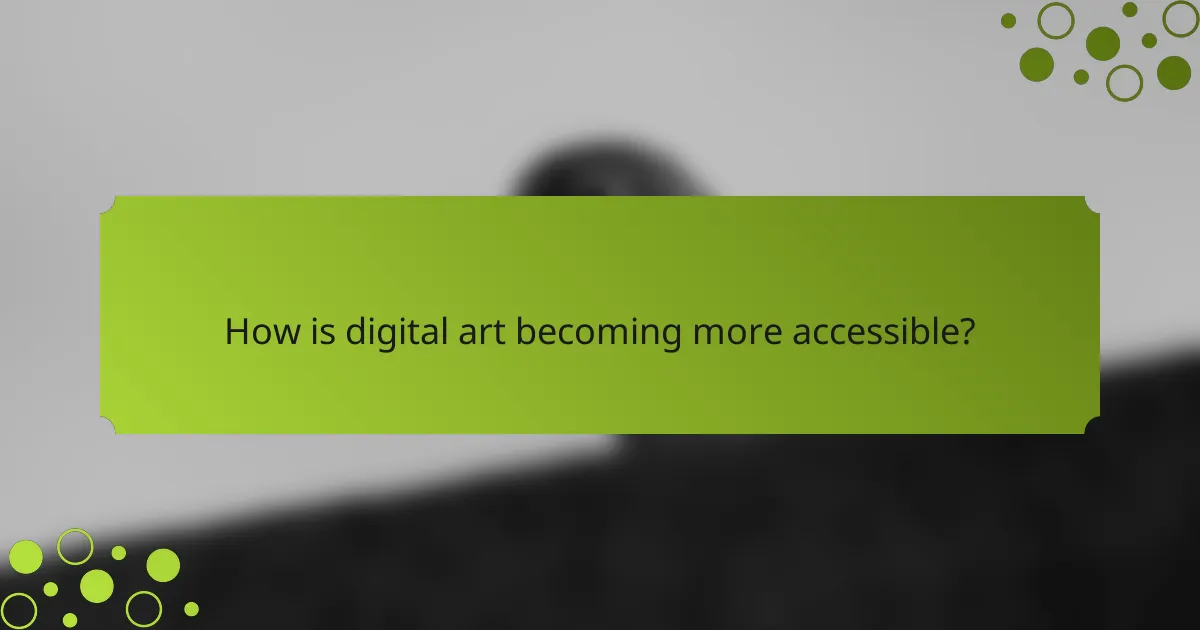
How is digital art becoming more accessible?
Digital art is becoming more accessible through various online platforms, affordable software tools, and community initiatives that support artists. These developments allow a broader range of individuals to create and share their artwork, regardless of their financial resources or technical skills.
Online platforms for artists
Online platforms like DeviantArt, ArtStation, and Behance provide artists with a space to showcase their work and connect with audiences. These sites often offer free accounts, enabling artists to display their portfolios without upfront costs.
Additionally, social media platforms such as Instagram and TikTok have become vital for artists to gain visibility and engage with potential buyers. By utilizing these platforms, artists can reach global audiences and build a following more easily than ever before.
Affordable software tools
The rise of affordable software tools has significantly lowered the barrier to entry for digital artists. Programs like Krita, GIMP, and Affinity Designer offer powerful features at little to no cost, making them accessible to beginners and professionals alike.
Subscription-based services like Adobe Creative Cloud also provide flexible pricing options, allowing artists to pay monthly rather than committing to a large upfront purchase. This flexibility can make high-quality tools more attainable for those on a budget.
Community art initiatives
Community art initiatives, such as local workshops and online courses, foster collaboration and skill development among artists. Many organizations offer free or low-cost classes that teach digital art techniques, making it easier for newcomers to learn and improve their craft.
Furthermore, initiatives like public art projects and exhibitions encourage artists to participate and showcase their work. These opportunities not only enhance visibility but also create a supportive environment where artists can share resources and experiences.
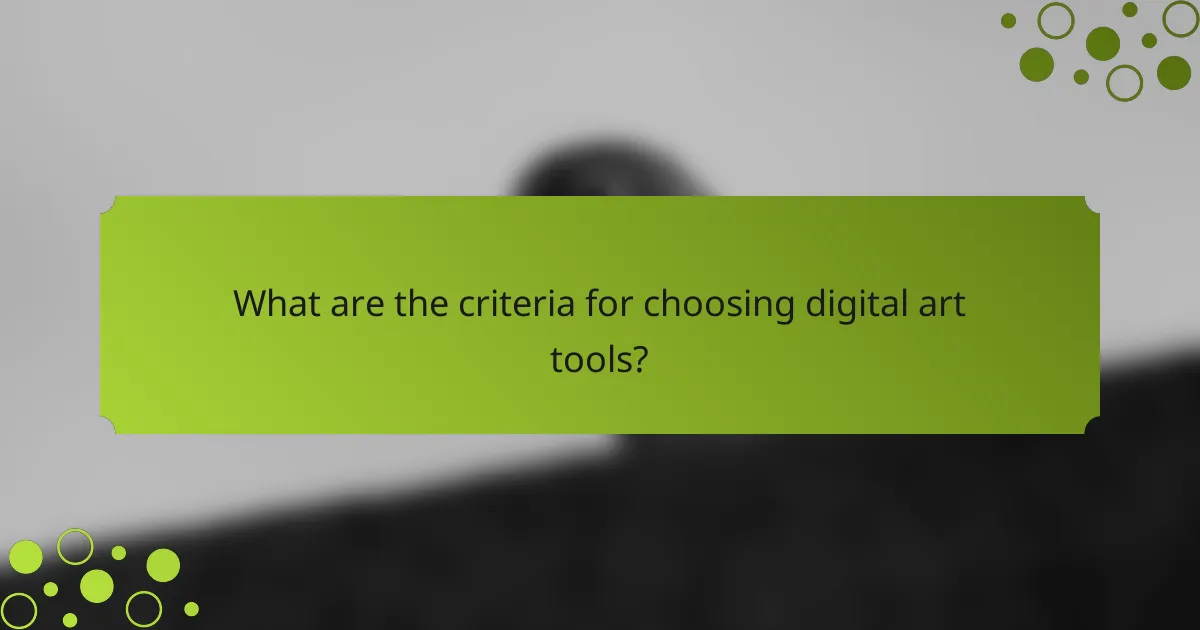
What are the criteria for choosing digital art tools?
Choosing digital art tools involves evaluating user-friendliness, cost, and compatibility with other technologies. These criteria help artists select tools that enhance their creative process and fit their budget.
User-friendly interfaces
User-friendly interfaces are crucial for artists, especially those new to digital art. Tools with intuitive layouts and easy navigation allow users to focus on creativity rather than struggling with complex features.
Look for software that offers customizable workspaces and tutorials. For instance, programs like Procreate and Adobe Fresco are designed with simplicity in mind, making them accessible for beginners while still offering advanced features for experienced users.
Cost-effectiveness
Cost-effectiveness is a key consideration when selecting digital art tools. Prices can vary widely, from free applications to expensive software subscriptions. Assessing your budget and the value each tool provides is essential.
Many artists find that investing in a one-time purchase software, like Corel Painter, can be more economical than ongoing subscription services. Additionally, exploring free or low-cost options, such as Krita or GIMP, can help beginners start without significant financial commitment.
Integration with other technologies
Integration with other technologies enhances the functionality of digital art tools. Compatibility with hardware like graphic tablets and software for animation or 3D modeling can streamline workflows and expand creative possibilities.
For example, tools that work seamlessly with Adobe Creative Cloud enable artists to move between applications like Photoshop and Illustrator effortlessly. Checking for compatibility with existing tools can save time and improve productivity.
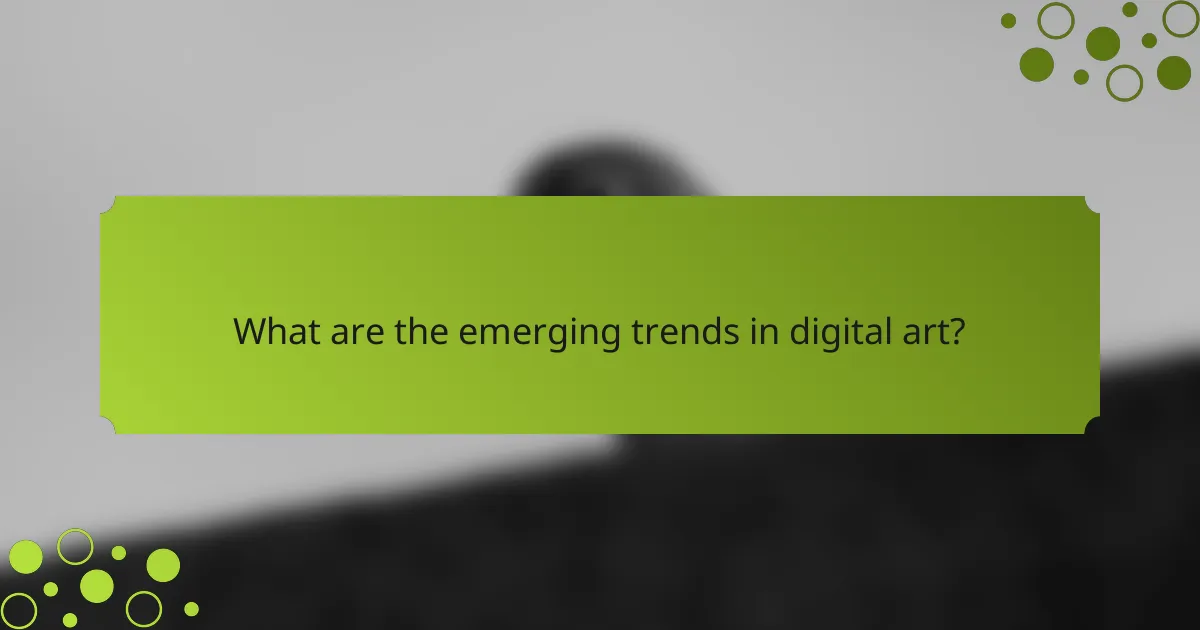
What are the emerging trends in digital art?
Emerging trends in digital art include the rise of collaborative projects and a focus on environmental themes. These trends reflect advancements in technology and a growing awareness of social issues, making digital art more accessible and relevant to contemporary audiences.
Collaborative art projects
Collaborative art projects leverage technology to bring together artists from diverse backgrounds, often across different geographical locations. Platforms like online galleries and social media enable artists to co-create and share their work in real-time, fostering a sense of community and shared purpose.
One notable example is the use of blockchain technology to create decentralized art platforms, allowing artists to collaborate without traditional gatekeepers. This approach not only democratizes art creation but also ensures that all contributors receive fair compensation for their work.
Environmental themes in digital art
Environmental themes are increasingly prevalent in digital art, as artists use their platforms to raise awareness about climate change and sustainability. This trend often manifests in works that incorporate data visualization, interactive installations, or augmented reality to engage audiences more deeply.
Artists may utilize digital mediums to depict the impact of human activity on nature, creating immersive experiences that encourage viewers to reflect on their environmental footprint. For instance, virtual reality experiences can simulate the effects of rising sea levels, providing a powerful visual representation of potential future scenarios.
